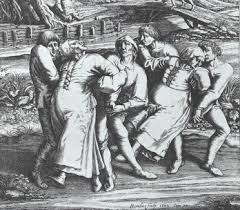Sydenham's chorea or chorea minor is a rare neurological disease, formerly called jerks. It is a form of chorea that occurs mainly in children (5-15 years). Typically are the jerky movements of the face or limbs. The symptoms usually last a few months and then disappear.
The term St. Veits dance is also used for the St. John's Disease, in which affected individuals have a morbid urge to (continue to) dance. This dance sigh or choreomanie was first observed in 1374 in Aachen.
 Paracelsus gave as three different causes: imagination, sensual desire and physical causes. Dance Sigh later also spread across the Netherlands. Still in the sixteenth century it was at Molenbeek (Brussels).
Paracelsus gave as three different causes: imagination, sensual desire and physical causes. Dance Sigh later also spread across the Netherlands. Still in the sixteenth century it was at Molenbeek (Brussels).
The main cause of the plague was, according to Hecker hysteria by religious frenzy. This resulted in seizure-like spasms, shock, and (what seemed like) dancing. Sometimes resulting in death.
Other explanations that have been suggested are poisoning by ergot and fear of prevailing plague (1347-1350). This would cause a kind of trance disorder.
Ergot is a fungus that grows on rye and wheat. The fungus produces ergot that causes hallucinations in overuse. Ergotamine can also cause itching disease (ergotismus).
In Italy it was thought that it came through the bite of the Tarantula, a poisonous spider.
St. Vitus Dance would also exist as ancient Germanic fairy dance. In mythology, it was an irresistible melody, which was brought by fairies. When a man heard it, he could not stop dancing, unless the tune was played reverse or someone broke the strings of the instrument. This dance played a role in the midsummer celebrations.
Saint Vitus is a saint and martyr of the Catholic Church. He was born in Sicily. When he was about seven years old, he became Christian. His outraged father tried to get him through torture again off Christianity. He fled to Rome. There he was tortured on 15 June 303. He was 12 or fourteen years. Yes, also in the civilized West were / are bipeds who are more animal than human. Or actually worse. He became the patron saint of the "dance sigh”.
Now there are in different places in Europe (dance) processions in honor of Saint Vitus.
A good explanation for the dancing procession tells the legend of Long Veit, a local horse thief in Luxembourg. He was sentenced to the gallows, and should be hanged on the market. At that time an execution was top entertainment: there was a mass audience. Veits last wish was granted, he could play one more time on his violin. The melody was so catchy that at no time everyone was dancing and making music. And had so much fun that they did not realize that Veit had took off.
Echternach is known for its annual jump procession on Whit Tuesday, as well as an expression for something that is not moving forward, "as the procession of Echternach”.
The principle is three steps forward and then two steps back, as one that would do in the conscious procession. But that seems not right. It would never, or certainly not long have been in use. There is jumped from the left to the right leg, each equally after heaving. Everyone in the queue washolding the end of a solid cloth. A sideways jump can give the impression of one step backwards.
It is assumed that since the early Middle Ages, the dance procession was a typical ' expilsion’ procession, with therapeutic purposes. By depiction through dance the dreaded diseases like the plague, epilepsy, St. Vitus Dance (spasms) did they defuse the disease, according to the principle 'same healed by the same".
